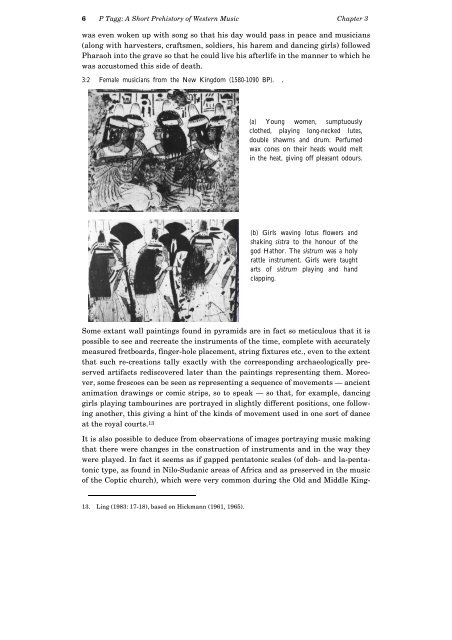A Short Prehistory of Western Music, Chapter 3
A Short Prehistory of Western Music, Chapter 3
A Short Prehistory of Western Music, Chapter 3
You also want an ePaper? Increase the reach of your titles
YUMPU automatically turns print PDFs into web optimized ePapers that Google loves.
6 P Tagg: A <strong>Short</strong> <strong>Prehistory</strong> <strong>of</strong> <strong>Western</strong> <strong>Music</strong> <strong>Chapter</strong> 3<br />
was even woken up with song so that his day would pass in peace and musicians<br />
(along with harvesters, craftsmen, soldiers, his harem and dancing girls) followed<br />
Pharaoh into the grave so that he could live his afterlife in the manner to which he<br />
was accustomed this side <strong>of</strong> death.<br />
3:2 Female musicians from the New Kingdom (1580-1090 BP). .<br />
Some extant wall paintings found in pyramids are in fact so meticulous that it is<br />
possible to see and recreate the instruments <strong>of</strong> the time, complete with accurately<br />
measured fretboards, finger-hole placement, string fixtures etc., even to the extent<br />
that such re-creations tally exactly with the corresponding archaeologically preserved<br />
artifacts rediscovered later than the paintings representing them. Moreover,<br />
some frescoes can be seen as representing a sequence <strong>of</strong> movements — ancient<br />
animation drawings or comic strips, so to speak — so that, for example, dancing<br />
girls playing tambourines are portrayed in slightly different positions, one following<br />
another, this giving a hint <strong>of</strong> the kinds <strong>of</strong> movement used in one sort <strong>of</strong> dance<br />
at the royal courts. 13<br />
It is also possible to deduce from observations <strong>of</strong> images portraying music making<br />
that there were changes in the construction <strong>of</strong> instruments and in the way they<br />
were played. In fact it seems as if gapped pentatonic scales (<strong>of</strong> doh- and la-pentatonic<br />
type, as found in Nilo-Sudanic areas <strong>of</strong> Africa and as preserved in the music<br />
<strong>of</strong> the Coptic church), which were very common during the Old and Middle King-<br />
13. Ling (1983: 17-18), based on Hickmann (1961, 1965).<br />
(a) Young women, sumptuously<br />
clothed, playing long-necked lutes,<br />
double shawms and drum. Perfumed<br />
wax cones on their heads would melt<br />
in the heat, giving <strong>of</strong>f pleasant odours.<br />
(b) Girls waving lotus flowers and<br />
shaking sistra to the honour <strong>of</strong> the<br />
god Hathor. The sistrum was a holy<br />
rattle instrument. Girls were taught<br />
arts <strong>of</strong> sistrum playing and hand<br />
clapping.














